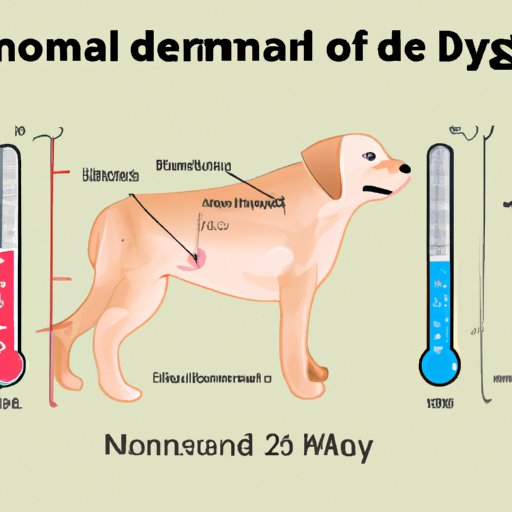Introduction
If you’re a dog owner, you know that your furry friend quickly becomes a beloved part of your family. That’s why it’s important to stay vigilant and aware of any changes in their health, such as fevers. If your dog has a fever, it could indicate a health problem that needs attention. In this article, we’ll explore how to tell if your dog has a fever and what to do about it. We’ll also provide information on preventing fevers in the first place and knowing when to seek veterinary attention.
Signs and Symptoms of a Fever in Dogs
The first step in identifying a fever in your dog is being aware of its signs and symptoms. These may include:
Lethargy
If your dog is unusually tired or lethargic, it could be a sign of a fever. Dogs with fevers may lack energy and enthusiasm for play, walks, and other activities.
Loss of Appetite
If your dog isn’t eating or drinking as much as usual, it could also be a sign of a fever. Dogs with fevers may not feel hungry or thirsty and may lose weight as a result.
Elevated Body Temperature
A dog’s normal body temperature is between 99.5–102.5 degrees Fahrenheit. If your dog’s temperature is above this range, it could be a sign of a fever.
Other Physical and Behavioral Changes
Dogs with fevers may also experience other physical and behavioral changes, such as vomiting, diarrhea, coughing, and sneezing. They may also appear restless, uncomfortable, or in pain.
It’s important to note that these symptoms may also be caused by other health problems. However, if you notice these symptoms in your pet, it’s important to observe them and take note of their behavior for future reference.
Importance of Observing Your Dog’s Symptoms
If you suspect that your dog has a fever, it’s best to keep an eye on their symptoms and record them for your veterinarian. This can include noting changes in behavior, appetite, and energy levels. It’s also important to take your dog’s temperature to confirm any suspicions of fever.

Understanding Normal Body Temperature in Dogs
Baseline Temperature Range
As noted earlier, a dog’s normal body temperature ranges from 99.5–102.5 degrees Fahrenheit. However, just like humans, a dog’s temperature can fluctuate depending on a range of factors, such as activity levels and environment. It’s essential to establish a baseline temperature range for your individual pet to know what is considered normal for them.
Differences in Temperature Between Dog Breeds and Sizes
It’s important to note that smaller dogs and puppies may have higher body temperatures than larger dogs. Additionally, certain dog breeds may have different baseline temperature ranges. It’s essential to learn what is normal for your specific breed and size of dog.
The Importance of Knowing Your Dog’s Normal Body Temperature
By knowing your dog’s normal body temperature, you can more easily identify when they have a fever and need attention. Additionally, measuring your dog’s temperature regularly can help establish a baseline and detect changes that may indicate a health problem.
Techniques to Accurately Measure Your Dog’s Temperature
Different Tools Available
There are several tools that pet owners can use to measure their dogs’ temperatures, including:
- Digital thermometers designed specifically for dogs
- Infrared thermometers
- Ear thermometers
Guidelines on How to Properly Use a Thermometer
It’s important to follow proper guidelines when measuring your dog’s temperature. This includes:
- Using a quality thermometer designed specifically for dogs
- Applying lubrication, such as petroleum jelly or water-based lubricant, to ensure comfort and easy insertion
- Gently inserting the thermometer in the rectum
- Holding the thermometer in place, without applying pressure, for up to three minutes or until you hear a beep
Tips to Ensure Accurate Readings
Some tips to ensure accurate temperature readings include:
- Using a thermometer that provides quick and accurate readings
- Observing your dog’s behavior for signs of discomfort or pain during the process
- Cleaning the thermometer with isopropyl alcohol or hydrogen peroxide before and after use to avoid infection
What to Do if You Suspect Your Dog Has a Fever
Contacting a Veterinarian
If you suspect that your dog has a fever, it’s important to contact your veterinarian right away. They can provide advice on what to do next and determine if your dog needs to come in for an appointment.
Treating the Symptoms at Home
In the meantime, you can take steps to help your dog feel more comfortable, such as:
- Offering plenty of water to prevent dehydration
- Giving them a comfortable, cool place to rest
- Making sure they get plenty of rest
Monitoring Your Dog’s Behavior
It’s important to monitor your dog’s behavior closely, noting any changes or new symptoms that may arise.
When To Seek Emergency Care
In some cases, a fever can be a sign of a life-threatening condition, such as heatstroke. It’s important to seek emergency care if your dog has a fever and is displaying symptoms such as:
- Rapid breathing or panting
- Vomiting or diarrhea
- Seizures
- Confusion or disorientation
Common Causes of Fever in Dogs
There are several health problems that can cause a fever in dogs, including:
Bacterial Infections
Bacterial infections can cause a fever in dogs, including diseases like Lyme disease and Rocky Mountain spotted fever.
Viral Infections
Viruses, such as parvovirus and distemper, can also cause fevers in dogs.
Other Health Conditions
Fevers can also be a sign of other health conditions, such as cancer, dental disease, or autoimmune disorders.
The Importance of Identifying the Cause of the Fever
Identifying the cause of the fever is important in determining the best treatment plan for your dog. Your veterinarian will perform diagnostic tests, such as blood work or imaging, to determine the underlying cause and develop an effective treatment plan.
How to Prevent Fevers in Your Dog
Regular Check-ups with a Veterinarian
Scheduling regular check-ups with your veterinarian can help detect health problems early on and prevent fevers from developing.
Proper Vaccinations
Proper vaccinations can also help prevent viral and bacterial infections that can cause fevers in dogs.
Healthy Habits and Lifestyle Choices
Maintaining a healthy diet, plenty of exercise, and good hygiene practices can help prevent a range of health problems in dogs.
Other Preventative Measures
Other preventative measures may include tick and flea prevention, dental care, and appropriate medication management.
When to Visit the Vet – How to know if your dog needs immediate medical attention
Serious Symptoms That Require Medical Attention
Some symptoms that require immediate medical attention include:
- Uncontrolled bleeding
- Difficulty breathing
- Paralysis or sudden weakness
- Loss of consciousness or seizures
Understanding the Need for Prompt Veterinary Care
It’s essential to seek veterinary care promptly if your dog is displaying any symptoms of illness. Early detection and treatment can help prevent a range of health problems and improve the chances of a full recovery.
Importance of Regular Check-ups and Monitoring Your Dog’s Health
Regular check-ups and monitoring your dog’s health can help detect and prevent health problems before they become serious. If you notice any changes in your pet’s behavior or health, don’t hesitate to contact your veterinarian.
Conclusion
In summary, being aware of the signs and symptoms of a fever in your dog can help you identify when your pet needs medical attention. Measuring your dog’s temperature regularly and knowing their baseline temperature range can make it easier to detect changes that may signal a fever. Staying proactive with regular check-ups and preventative measures can help keep your dog healthy and prevent a range of health problems.
Remember, if you suspect that your dog has a fever, contact your veterinarian right away and pay close attention to any changes in their behavior or health. By being vigilant and attuned to your pet’s needs, you can help keep them happy and healthy for years to come.
